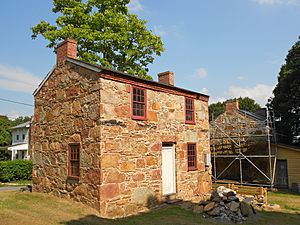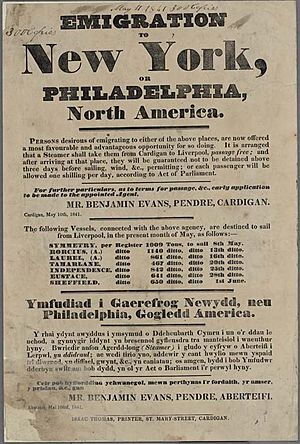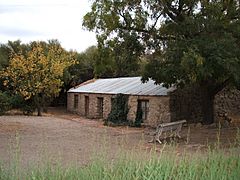Welsh settlement in the Americas facts for kids
Welsh settlement in the Americas is about how people from Wales moved to the Americas and tried to create their own Welsh communities. This was part of the bigger movement of people from Great Britain settling in the New World.
Contents
Did a Welsh Prince Discover America? The Madoc Legend
Imagine a story from the 16th century! It claimed that a Welsh prince named Madoc was the very first European to see America. This was supposedly way back in 1170. The story says Madoc was the son of Owain Gwynedd, a prince from Gwynedd in Wales.
He supposedly left Wales with a group of settlers because of problems with who would rule next. They sailed west and landed near the Mississippi River. There, they started a colony. Later, these Welsh settlers supposedly mixed with the Native Americans.
In the late 1500s, writers like John Dee used this legend. They wanted to support England's claim to North America. The story became popular again in the 1700s. People even told tales of Native Americans who spoke Welsh! However, most experts today believe this exciting story is not true.
Welsh Communities in North America
Many Welsh people moved to the United States and Canada. But only a few groups tried to set up completely separate Welsh colonies. For example, Sir William Vaughan sent Welsh settlers to Renews, Newfoundland in 1617. He wanted to start a lasting colony, but it didn't work out.
Vaughan tried again to create a colony at Trepassey. He called it Cambriol. This area later became the Province of Avalon. It was named after a place in England, linking it to early Christianity in Britain.
Pennsylvania: A Welsh Promise Broken

In the 1600s, many Quakers from Wales moved to Pennsylvania. William Penn, who founded Pennsylvania, promised them they could create a Welsh colony there. This area was called the Welsh Tract. The idea was for it to be a separate county where the local government would use the Welsh language. This was important because many settlers only spoke Welsh.
However, this promise was not kept. By the 1690s, the land was divided into different counties. The Welsh Tract never became its own self-governing area.
Later, in the late 1700s, a Welsh colony named Cambria was started. Morgan John Rhys established it in what is now Cambria County, Pennsylvania.
Between 1856 and 1867, Samuel Roberts tried to start another Welsh colony. This one was at Brynffynnon, Tennessee. Also, Michael D. Jones made plans for colonies in Wisconsin, Oregon, and British Columbia. But these plans never happened.
Idaho: Keeping Welsh Traditions Alive
Welsh pioneers settled Malad Valley in the 1860s. They brought their Welsh traditions with them. One very important tradition was the annual eisteddfod. This was a music and poetry contest, just like the ones held in Wales for over 900 years!
The Malad Valley eisteddfod was a yearly cultural event. It took place in Malad and Samaria in alternating years. Judges came from Salt Lake City to pick the best singers, musicians, and recitations. It was an all-day event, with people traveling from all over Oneida County. This custom continued until 1916, when World War I began.
Tennessee: Welsh Workers and Community
After the American Civil War, 104 Welsh immigrant families moved from Pennsylvania to East Tennessee. These families settled in an area of Knoxville now called Mechanicsville. Joseph and David Richards recruited these families to work in a rolling mill. This mill was partly owned by John H. Jones.
The Richards brothers also helped start the Knoxville Iron Works. It was built next to the L&N Railroad. This site was later used for the 1982 World's Fair. Only one building from the original Iron Works remains today. It now houses a restaurant called 'The Foundry'.
The Welsh immigrants first met at the Second Presbyterian Church. Then, in 1870, they built their own Congregational Church. The Reverend Thomas Thomas was their first pastor. However, the church property was sold by 1899.
These Welsh families became successful. They started other businesses in Knoxville. These included a company that built coal cars, several slate roofing companies, a marble company, and furniture companies. By 1930, many Welsh families moved to other parts of the city and nearby counties like Sevier County. Today, over 250 families in the Knoxville area can trace their family history directly to these first immigrants. They still remember their Welsh heritage by celebrating St. David's Day.
Ohio: Welsh Farmers and Their Roots
Jackson and Gallia counties in Ohio were settled by Welsh immigrants in the 1800s. Many of these settlers came from the Ceredigion area of West Wales.
New York: A Strong Welsh Cultural Center
In 1795, Welsh immigrants settled in the village of Remsen, New York. Their families became successful dairy farmers there. Many stone houses and barns in the area still show their Welsh heritage. Oneida County and Utica, New York became a major cultural center for Welsh-Americans in the 1800s.
After bad harvests in Wales in 1789 and 1802, and dreaming of owning land, the first five Welsh families soon attracted more farmers. They settled in Steuben, Utica, and Remsen townships. The first Welsh settlers arrived in the 1790s. Many Welsh immigrants also settled in the town of Freedom and nearby townships in Cattaraugus County in southwestern New York during the 1800s.
In 1848, a writer named John Russell Bartlett noticed that Oneida County had many Welsh language newspapers and magazines. It also had Welsh churches. Bartlett even wrote that "one may travel for miles (across Oneida County) and hear nothing but the Welsh language." By 1855, there were four thousand Welsh people in Oneida.
After the Civil War, many New York Welsh people began moving west. They went especially to Michigan and Wisconsin. They ran small farms and held onto their old traditions. The church was the heart of Welsh community life. A lively Welsh-speaking newspaper kept their ethnic identity strong. The Welsh slowly became part of the larger American society. But they didn't completely give up their own cultural ways. The Welsh language was still spoken in the area well into the 1970s.
Welsh Communities in South America
In 1852, Thomas Benbow Phillips from Tregaron, Wales, started a settlement. About 100 Welsh people moved to the state of Rio Grande do Sul in Brazil. Many of these settlers later moved to a more successful colony in Argentina. This colony is known as Y Wladfa ("The Colony").
The most famous Welsh colony is in the Chubut Valley of Patagonia. It is called Y Wladfa Gymreig ("The Welsh Colony"). It began in 1865 when 153 settlers landed at what is now Puerto Madryn. Before this, the settlers had an agreement with Argentina's minister of the interior, Guillermo Rawson. The agreement said the colony would become one of Argentina's states once its population reached 20,000. However, the Argentinian Congress did not approve this promise. They worried that the British government might use the settlers as an excuse to take over Patagonia.
See also



